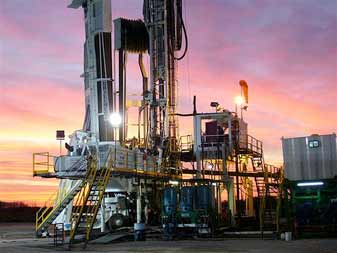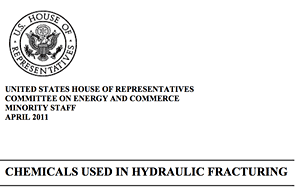Committee Democrats Release New Report Detailing Hydraulic Fracturing Products: Chemicals Used in Hydraulic Fracturing
Publication Type:
Government ReportSource:
U.S. Congress, Washington, D.C., p.1-32 (2011)URL:
http://democrats.energycommerce.house.gov/index.php?q=news/committee-democrats-release-new-report-detailing-hydraulic-fracturing-productsKeywords:
governmentNotes:
Apr 16, 2011
Today Energy and Commerce Committee Ranking Member Henry A. Waxman, Natural Resources Committee Ranking Member Edward J. Markey, and Oversight and Investigations Subcommittee Ranking Member Diana DeGette released a new report that summarizes the types, volumes, and chemical contents of the hydraulic fracturing products used by the 14 leading oil and gas service companies.
The report contains the first comprehensive national inventory of chemicals used by hydraulic fracturing companies during the drilling process.
“Hydraulic fracturing has helped to expand natural gas production in the United States, but we must ensure that these new resources don’t come at the expense of public health,” said Rep. Waxman.
“This report shows that these companies are injecting millions of gallons of products that contain potentially hazardous chemicals, including known carcinogens. I urge EPA and DOE to make certain that we have strong protections in place to prevent these chemicals from entering drinking water supplies.”
See: U.S. Congress. Committee on Energy and Commerce. Minority Staff (Henry Waxman, Edward Markey, Diana DeGette). "Chemicals Used in Hydraulic Fracturing". Washington, D.C. April 2011. (PDF)
Universal Well Services, for example, told the Committee that it “obtains hydraulic fracturing products from third-party manufacturers, and to the extent not publicly disclosed, product composition is proprietary to the respective vendor and not to the Company.”31
Complete Production Services noted that the company always uses fluids from third-party suppliers who provide an MSDS for each product. Complete confirmed that it is “not aware of any circumstances in which the vendors who provided the products have disclosed this proprietary information” to the company, further noting that “such information is highly proprietary for these vendors, and would not generally be disclosed to service providers” like Complete.32
Key Energy Services similarly stated that it “generally does not have access to the trade secret information as a purchaser of the chemical(s).”33
Trican also told the Committee that it has limited knowledge of “off the shelf” products purchased from a chemical distributor or manufacturer, noting that “Trican does not have any information in its possession about the components of such products beyond what the distributor of each product provided Trican in the MSDS sheet.”34
In these cases, it appears that the companies are injecting fluids containing unknown chemicals about which they may have limited understanding of the potential risks posed to human health and the environment.
VI. CONCLUSION
Hydraulic fracturing has opened access to vast domestic reserves of natural gas that could provide an important stepping stone to a clean energy future. Yet questions about the safety of hydraulic fracturing persist, which are compounded by the secrecy surrounding the chemicals used in hydraulic fracturing fluids.
This analysis is the most comprehensive national assessment to date of the types and volumes of chemical used in the hydraulic fracturing process.
It shows that between 2005 and 2009, the 14 leading hydraulic fracturing companies in the United States used over 2,500 hydraulic fracturing products containing 750 compounds. More than 650 of these products contained chemicals that are known or possible human carcinogens, regulated under the Safe Drinking Water Act, or listed as hazardous air pollutants.
31. Letter from Reginald J. Brown to Henry A. Waxman, Chairman, Committee on Energy and Commerce, and Edward J. Markey, Chairman, Subcommittee on Energy and Environment (Apr. 16, 2010).
32. Letter from Philip Perry to Henry A. Waxman, Chairman, Committee Energy and Commerce, and Edward J. Markey, Chairman, Subcommittee on Energy and Environment (Aug. 6, 2010).
33. E-mail from Peter Spivack to Committee Staff (Aug. 5, 2010).
34. E-mail from Lee Blalack to Committee Staff (July 29, 2010).
by Ian Urbina:
Oil and gas companies injected hundreds of millions of gallons of hazardous or carcinogenic chemicals into wells in more than 13 states from 2005 to 2009, according to an investigation by Congressional Democrats.
...“Questions about the safety of hydraulic fracturing persist, which are compounded by the secrecy surrounding the chemicals used in hydraulic fracturing fluids,” said the report, which was written by Representatives Henry A. Waxman of California, Edward J. Markey of Massachusetts and Diana DeGette of Colorado.
...Some of the ingredients mixed into the hydraulic fracturing fluids were common and generally harmless, like salt and citric acid. Others were unexpected, like instant coffee and walnut hulls, the report said. Many of the ingredients were “extremely toxic,” including benzene, a known human carcinogen, and lead.
...Ms. Degette, and Representative Maurice D. Hinchey, Democrat of New York, recently reintroduced the FRAC Act, a bill that would require chemical disclosure from all drilling companies, including a provision that companies release proprietary information to health professionals if it is needed for treatment. The FRAC Act would also create an online registry of chemicals on a well-by-well basis, but it would require drillers to disclose what they plan to use before they fracture a well, as well as a post-fracturing report.
See: Urbina, Ian. “Millions of Gallons of Hazardous Chemicals Injected Into Wells, Report Says.” The New York Times 16 Apr. 2011. Web. 17 Apr. 2011.
See also: Texas Oil and Gas Acciountability Project. The Dark Side of the Boom: How Natural Gas Drilling in Texas Threatens Public Health and Safety: Sen. Lon Burnam Joins Calling for ‘Urgent’ Reforms
Thursday, April 14, 2011
Flowback: How the Texas Natural Gas Boom Affects Health and Safety
TEXAS OIL & GAS ACCOUNTABILITY PROJECT
FOR IMMEDIATE RELEASE: April 14, 2011
The Dark Side of the Boom: How Natural Gas Drilling in Texas Threatens Public Health and Safety: Sen. Lon Burnam Joins Calling for ‘Urgent’ Reforms
AUSTIN, TX, APRIL 14 – State, local and federal officials and regulatory agencies are failing to protect Texans from the health and safety risks of the natural gas boom, according to a report released today by the Texas Oil & Gas Accountability Project (OGAP).










